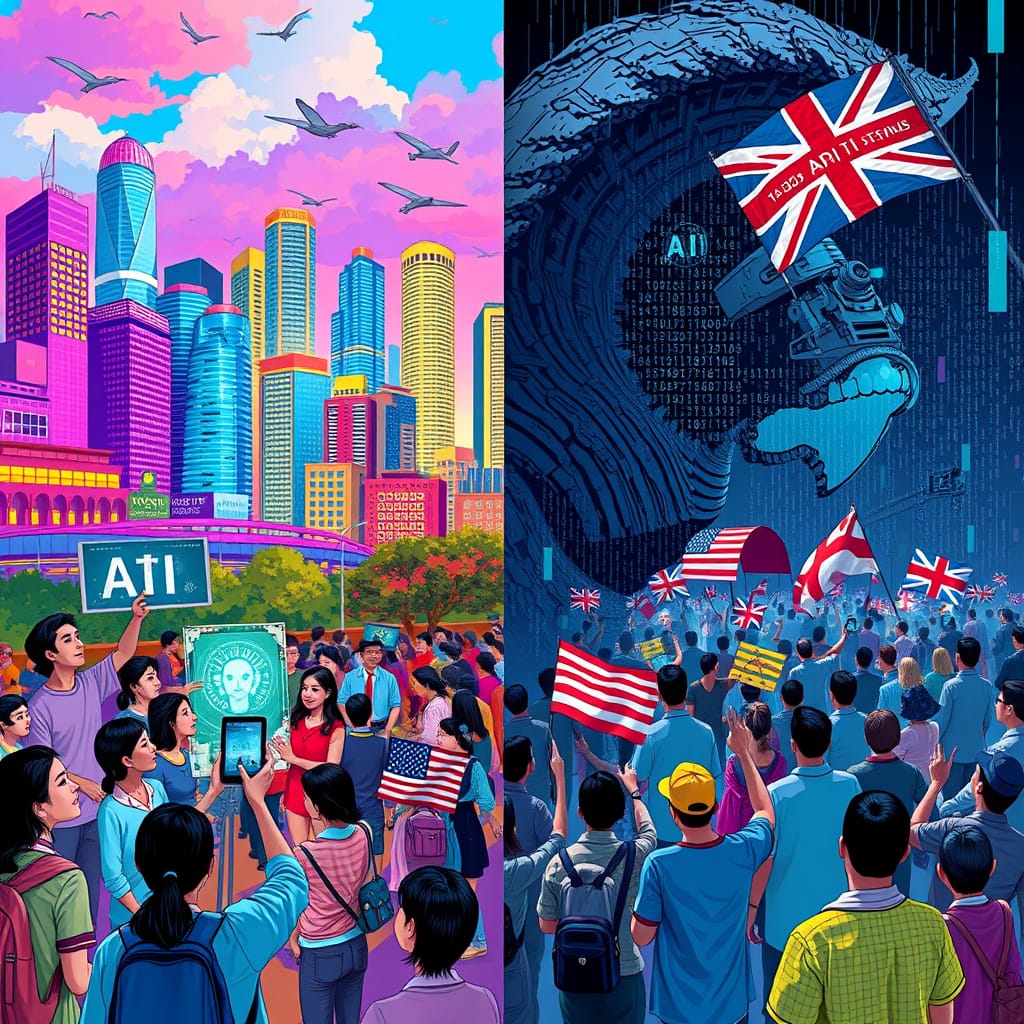In a world where artificial intelligence threatens to turn half the human workforce into digital dinosaurs faster than you can say “prompt engineering,” Singapore has done something so sensible it borders on the surreal: they’ve decided to actually prepare their citizens for the future instead of arguing about whether ChatGPT has feelings.
The city-state’s new public education initiative offers displaced workers a completely free second degree in emerging fields—a move so pragmatic it feels like stumbling through the looking glass into a dimension where governments actually solve problems before they become existential crises. Meanwhile, the West continues its grand tradition of treating technological disruption like an unexpected British weather pattern that might blow over if we just ignore it hard enough.
Down the Rabbit Hole of Rational Policy
Singapore’s approach reads like a fever dream of competent governance. Picture this: a government that looked at the approaching AI tsunami and thought, “Perhaps we should teach people to surf rather than debate whether the AI wave is morally justified in being wet.” The program specifically targets workers whose jobs are being automated away by AI, offering them pathways into fields that complement rather than compete with artificial intelligence.
Dr. Melissa Chen, Singapore’s Deputy Minister of Future-Proofing (a job title that would make EU bureaucrats break out in hives), explained the rationale with characteristic Singaporean directness: “We observed that arguing about AI ethics while your population becomes unemployable is roughly equivalent to re-arranging deck chairs on the Titanic, except the deck chairs are also being automated.”
The program covers everything from AI prompt engineering to human-AI collaboration frameworks, biotechnology, sustainable urban planning, and what they’re calling “empathy architecture”—designing systems that require uniquely human emotional intelligence. It’s as if someone took a hard look at the future and asked, “What will humans still be better at when machines can do everything else?”
The Western Response: A Masterclass in Missing the Point
Contrast this with the West’s approach, which resembles a group therapy session for people who refuse to acknowledge they have a problem. While Singapore builds bridges to the future, American universities continue churning out degrees in fields that will be as relevant as blacksmithing by 2030, charging students the GDP of small nations for the privilege.
The European Union, not to be outdone in bureaucratic magnificence, has responded to AI displacement by forming a committee to study the formation of a subcommittee that will eventually recommend the creation of a working group to examine the possibility of maybe thinking about retraining programs sometime after 2035.
“We’re taking a measured approach,” explained Brussels-based policy analyst François Delacroix, whose job description apparently involves using as many words as possible to say absolutely nothing. “We believe in the importance of stakeholder engagement and multi-lateral dialogue frameworks before implementing any paradigm-shifting educational restructuring initiatives.”
Translation: “We’ll hold meetings about having meetings until the robots have already taken over.”
The Productivity Paradox: More Output, Fewer Humans
Singapore’s leadership grasped something that Western policymakers seem constitutionally incapable of understanding: AI won’t necessarily replace humans because it’s better at everything, but because it makes the humans who remain exponentially more productive. It’s not about artificial intelligence being smarter than us—it’s about AI-augmented humans being so much more efficient that you need far fewer of them.
Consider the implications: if one AI-assisted financial analyst can do the work of ten traditional analysts, nine people are suddenly redundant. If one AI-enhanced doctor can diagnose patients with the accuracy of an entire medical team, most of that team becomes unnecessary overhead. The math is brutal in its simplicity.
“We’re not heading toward a Star Trek utopia where everyone pursues art and philosophy,” noted Singapore’s Chief Technology Strategist, Dr. Raj Patel, with the kind of clear-eyed realism that makes Western optimists uncomfortable. “We’re heading toward something more like The Expanse—a future where the gap between the AI-augmented elite and everyone else becomes a chasm that makes today’s inequality look quaint.”
The Great Divergence: Asia Builds, the West Debates
While Singapore methodically prepares its workforce for an AI-dominated economy, the West remains trapped in ideological debates that would be amusing if they weren’t so catastrophically counterproductive. American politicians argue about whether AI is “woke” or “based,” as if political affiliation will somehow protect their constituents from economic obsolescence.
The irony is delicious: the same Western nations that spent decades lecturing the world about free markets and creative destruction are now paralyzed by the prospect of their own populations being creatively destroyed by market forces they helped unleash.
Singapore, meanwhile, has embraced what they call “pragmatic futurism”—a philosophy that treats technological change as a force of nature to be prepared for rather than a political position to be debated. Their education ministry has partnered with major tech companies to create curricula that evolve in real-time with technological advancement, ensuring graduates enter a job market that actually exists rather than one that existed when their professors were students.
The Retraining Reality Check
The most sobering aspect of Singapore’s initiative isn’t its innovation—it’s the implicit acknowledgment that traditional career paths are becoming extinct with the speed of a software update. The program’s existence is essentially a government-sponsored admission that the social contract of “get educated, work hard, retire comfortably” has been terminated without notice.
“We’re essentially teaching people to become cyborgs,” admitted program coordinator Dr. Sarah Lim, with the matter-of-fact tone of someone describing the weather. “Not literally, of course, but functionally. The future belongs to humans who can seamlessly integrate with AI systems, not humans who compete against them.”
The curriculum includes modules on “AI psychology”—understanding how machine learning systems make decisions so humans can work with rather than against algorithmic logic. Students learn to think like their artificial colleagues, developing what educators call “hybrid cognition.”
The Coming Reckoning
As Singapore builds its AI-ready workforce, the West faces a choice that it seems determined to avoid making until it’s too late. The next five years will likely see the beginning of what economists are euphemistically calling “structural employment adjustments”—a phrase that makes mass unemployment sound like a minor accounting error.
The signs are already visible for those willing to look. Customer service jobs are disappearing into AI chatbots. Financial analysts are being replaced by algorithms that never need coffee breaks or vacation time. Even creative fields aren’t safe—AI can now write marketing copy, design logos, and compose music with efficiency that makes human creativity look like an expensive luxury.
Singapore’s bet is that by the time the AI displacement wave hits full force, they’ll have a population equipped to ride it rather than be crushed by it. The West’s bet appears to be that if they ignore the wave long enough, it might decide to hit someone else instead, preferably China.
The Expanse Scenario
The reference to The Expanse isn’t hyperbolic—it’s prophetic. In that fictional universe, humanity has spread across the solar system, but society has stratified into distinct castes: the technologically augmented elite who control resources and infrastructure, and the masses who survive on basic universal income and whatever scraps of meaningful work remain.
Singapore seems to understand that in an AI-dominated economy, there will be two classes of humans: those who control and collaborate with artificial intelligence, and those who are controlled by it. Their education program is essentially a massive effort to ensure as many citizens as possible end up in the first category.
The West, meanwhile, continues to operate under the delusion that democracy and good intentions will somehow exempt them from economic physics. It’s a touching faith in the power of wishful thinking over mathematical reality.
What’s your take on Singapore’s approach to AI displacement? Are we really heading toward The Expanse scenario, or is there still time for the West to course-correct? Share your thoughts below—especially if you’re currently working in a field that might not exist in five years.
Enjoyed this dose of uncomfortable truth? This article is just one layer of the onion.
My new book, “The Subtle Art of Not Giving a Prompt,” is the definitive survival manual for the AI age. It’s a guide to thriving in a world of intelligent machines by first admitting everything you fear is wrong (and probably your fault).
If you want to stop panicking about AI and start using it as a tool for your own liberation, this is the book you need.
>> Get your copy now (eBook & Paperback available) <<





GIPHY App Key not set. Please check settings